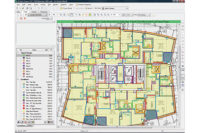Introduction
I want to revisit an ongoing conversation I have been having with Norb Slowikowski, president of Slowikowski & Associates. Norb has worked in the construction industry since 1982. He is a renowned productivity expert who has helped more than 300 contractors to improve their productivity to maximize their profitability. He and I have been discussing the importance of organization to the result of profitability. The following is the first part of our second conversation together.
Last year I shared a two-part piece from a webinar series we collaborated on. The earlier articles in the “Get Organized to Get Profitable” series focused on The Inextricable Link between profit and productivity. This article focuses on:
- Creating processes that ensure alignment between the office and the field
- Implementing key job controls in every phase of the overall project

Slowikowski maintains that contracting organizations that follow the practices listed above will realize numerous benefits, including reducing costly mistakes, increasing communication and collaboration, saving time and money, and ultimately, increasing the profitability of projects.
Ensuring Alignment between the Office and the Field
Construction productivity is a hot topic because it directly impacts profit. Construction managers, like managers in most areas of business, are feeling the pressure to “do more with less.” Numerous books and articles have been written that discuss how benchmarking, reengineering and quality management can be applied to the construction industry. While all these initiatives have merit, there is one area of focus that has a direct impact on productivity and which can be achieved at a relatively low cost: alignment between the office and the field.
Such alignment helps make teamwork a reality. The proper alignment of a contractor’s operations is essential to effectively support the field and to ensure that key job controls are in place for each phase of the construction process.
Contractors can think of their processes, whether they are manual or automated, as the foundation which supports every phase of a job. Every contractor has numerous processes such as estimating, project management, field operations, warehousing, distribution, and back office support including accounting and purchasing. While these processes exist, are they aligned in the most effective manner to support the end goal of minimizing waste and maximizing profits?
Here’s an example of how “misalignment” can be damaging to productivity. Consider the contractor that has put automation tools on the desks of the office staff. Estimators have on-screen blueprints, draftsmen have computer-aided design tools, and so on. Everything is computerized, modern and efficient. In the field, however, the project manager (PM) walks around with a clipboard, taking notes and working from printed reports that were generated days ago. When he returns to his trailer, he sends his status notes via email. The recipient in the office has to input the notes into the computer systems. While everyone is working to the best of their ability with the given tools, there’s a disconnect in the company’s processes. As a result, the flow of information throughout the organization is hindered, and this is harmful to productivity.
Contractors must create a consistent way of doing things so that everyone is following the same processes and not doing things on their own. When there is a breakdown in the flow of information from one area in the construction process to the next, the result will be lost productivity and increased costs—and that translates to reduced profits.
Key Job Controls Throughout Every Project Phase
Contractors intuitively know they must be organized to run the business smoothly. Organizing a construction job requires dividing up work among crew members; assigning work and providing clear instructions for carrying out assigned activities; linking up the field with a support system; defining the PM’s role in supporting the job site foremen; and planning and anticipating ongoing needs for job site productivity.
To complete the organizing process, it’s important to have key job controls in place across all phases of a project to ensure that the job site work flows smoothly from beginning to end and that the GC's expectations are met. Without key job controls, the project begins to “manage you.”
A “control” is basically a time for the project leaders to come together to update each other and synchronize their plans. A control could be a meeting, or a document such as a percent complete report, that allows a GM, PM or foreman to understand if project milestones are being met satisfactorily.
There are four phases to the construction process:
Phase 1—Startup
The Job Information Package: Every foreman should receive a comprehensive job information package from the PM before any job related meetings are conducted. The package should include, at a minimum, the scope of work, the quality specs, material lists, a stocking list, contractual requirements for the sub-contractor, how to do all the paperwork, how to process extra work authorizations, and change orders instructions. Foremen need this information to move forward with the job without constantly calling back to the office for information. This is a critical packet that helps foremen maintain good organization on the job site.
Blueprint and Estimating Review Meeting: The PM and the foremen review both the job plans and the estimates so they can clear the air on anything that may confuse or cause them concern, and to gain a clear picture of how that job was estimated and what needs to be done for that job.
General Contractor Meeting: Here the PM meets with the GC so that they can align expectations and eliminate any confusion that might lead to work disruptions later.
Key Job Responsibilities: Both in the office and the field, everyone must understand their responsibilities along with expected results and the standards by which they are measured by. There should be an accountability checklist to assure that people are executing their key responsibilities effectively and efficiently.
Phase 2—Job Prep and Planning
Pre-Job Planning Meeting: This meeting is conducted by the PM to share all project related information with all of the key participants, such as the foremen, the estimator, the safety manager and the warehouse coordinator. The group reviews the project information and develops their tactical plans on how they’re going to execute the day-to-day activities.
Job Site “Walk Around”: After the pre-job planning meeting, it’s very beneficial for all of the meeting participants to visit the job site so the project leaders can get a better feel for the job, develop questions and modify their individual tactical plans as necessary.
Contractors’ Responsibilities: Approximately a week before the job starts, the PM and the foremen should have another meeting to go over three key pieces of information for each contracted organization: the scope of work, quality specs for the job, and the contractor’s responsibilities as outlined in the contract.
Phase 3—Job-in-Progress
This is the longest phase where there is a lot of interaction among the PM, the foremen and the GC superintendent as the job progresses.
The Job Site Visit Report: When a PM visits the job, he is there at a minimum to resolve issues, communicate and exchange information with the foremen. The tool to facilitate this visit is the job site visit report which is a checklist of items to be reviewed on the job.
If possible the PM should walk the job with the foremen looking at the same things on the job site visit report. After the walk around, both the PM and foremen should review all of the items that were done well on the job and what needs to be improved. From this an action plan should be established to eliminate the “needs improvement” items by the team.
The “Daily Huddle”: Foremen must set production goals for their crews where each assigned task has a deadline, and they must communicate these goals to their teams. Every morning before work begins; the foremen should hold a daily huddle with their crews. The purpose of this meeting is to enhance teamwork by discussing the goals for the day, reviewing safety issues and obtaining input from the crew on what they need help with.
Weekly and Two Week Look-Ahead Plans: Planning starts with the goal of where a contractor wants to be by a certain point in time. The foremen should be documenting (i.e., writing down, not keeping in their heads) all the tasks that will be performed during the week with the goal of projecting where the project will be at the end of the week. The plan also should include what materials, equipment and labor are needed to complete the activities and the hours and cost that are budgeted to get everything done.
Labor Budget: Managing the labor budget back to the overall project estimated hours is extremely important. The PM must use consistent labor codes to assign/track tasks hours against. These codes provide feedback to both the office and the estimators to improve the estimation process. If the labor budget has been exceeded, the codes help to facilitate further analysis to determine why the project went over budget.
Status Reports: These reports are often the means for tracking overall productivity of the project. The office needs information from the field to determine the profitability of the job as it progresses.
An effective job site reporting system should include a daily log, a weekly job progress report, a daily job site report, an expense report for job site material purchases and a field work order for handling extra work requests.
One of the most important pieces of paperwork (and keep in mind that this “paperwork” can be done via computer) is the extra work authorization. Extra work should not proceed without the written authorization of the GC. If the GC won’t sign off on the extra work authorization, the request must be escalated to the PM.
Material checklists: It’s important to ensure that all the material arrives on to the job site according to schedule, in the right amount and the right type, and that there is a stocking plan for the job with a corresponding GC approved lay-down area for the material.
Phase 4—Job Closeout
The Punch List: Foremen need to develop a Punch List while the job is still mobilized, and they should coordinate this Punch List preparation with the GC superintendent and the PM. The foremen also could invite the GC’s superintendent to walk the job with them to develop the Punch List. If this is not an option, the foremen should develop the Punch List and then review it with the GC’s superintendent.
Demobilization Inventory: As the project winds down, the foremen should conduct a final job walk-around to ensure that all equipment is ready to be returned to the shop or warehouse. A final inventory of tools, equipment and materials should be taken and reviewed with the superintendent, who will help determine what will be returned to the warehouse and what items will be disposed of on the job site.
The foremen should compare the final inventory to the initial tool and equipment inventory and account for all discrepancies. It’s important that accountability exists for tools and equipment so that sound cost controls can be maintained.
Customer Post Job Review: When the job is completed, the PM should conduct a post job review with the GC to obtain feedback about the “positive” and “needs improvement” areas from the project. If the PM wants to work more projects with the GC in the future, this review helps the PM see where his company must improve to avoid repeating problems on future jobs.
Internal Post Job Review: The PM should conduct a post job review meeting with his own people at the end of the job. This is an opportunity to analyze everything that transpired during the job, and to determine what was done right, what problems existed and what must be done to correct issues going forward.





Report Abusive Comment